You’ll create an eco-friendly accessory workshop by choosing 100% recycled metals and ethically certified gemstones while implementing zero-waste techniques like scrap collection systems and water recycling loops. Focus on timeless designs over trendy pieces, use reclaimed materials for unique character, and establish transparent supplier relationships with proper certifications. Price your pieces to reflect true environmental costs and build community through shared sustainable values. These foundational practices will transform your creative space into an environmentally responsible haven.
Choose 100% Recycled Metals and Reclaimed Materials
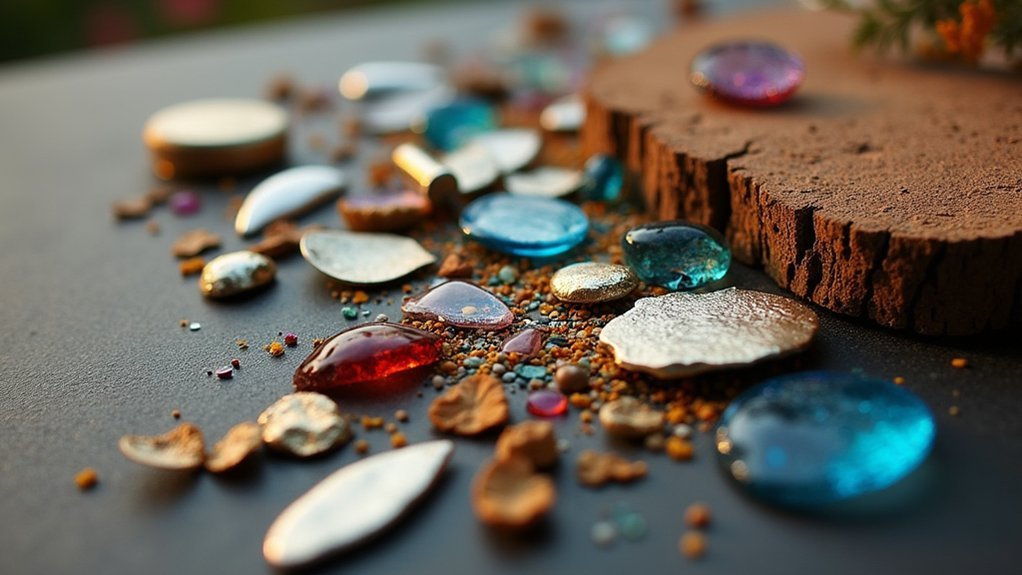
Transform your accessory-making practice by choosing 100% recycled metals and reclaimed materials as your primary resources.
When you select recycled metals like silver and gold, you’re dramatically reducing the environmental impact of mining, which causes deforestation and water pollution. You’ll find numerous suppliers offering certified 100% recycled materials to guarantee authenticity.
Reclaimed materials add unique character to your sustainable jewelry pieces while minimizing waste.
Repurposed elements breathe fresh life into eco-conscious designs, transforming discarded treasures into meaningful, waste-reducing statement pieces.
These materials give new life to existing resources, reducing demand for raw materials. You can create one-of-a-kind accessories that tell compelling stories through their repurposed elements.
Source Ethically Certified Gemstones and Lab-Grown Alternatives
When you’re selecting gemstones for your sustainable accessories, you’ll want to prioritize ethically certified options that guarantee responsible mining practices and fair labor conditions. Look for Fairtrade Gold and Fairmined Gold certifications when sourcing your materials.
| Ethical Option | Key Benefit |
|---|---|
| Lab-grown diamonds | Conflict-free production |
| Ethically sourced stones | Fair labor conditions |
| Recycled gemstones | Reduced mining demand |
| Certified suppliers | Transparent sourcing |
| Reclaimed materials | Lower carbon footprint |
Lab-grown diamonds offer exceptional alternatives to traditionally mined stones, providing conflict-free options with greatly reduced environmental impact. Research suppliers who demonstrate transparency in their sourcing practices, allowing you to trace gemstone origins. Using recycled gemstones minimizes your carbon footprint while supporting suppliers committed to sustainable practices and community reinvestment.
Implement Zero-Waste Production Techniques
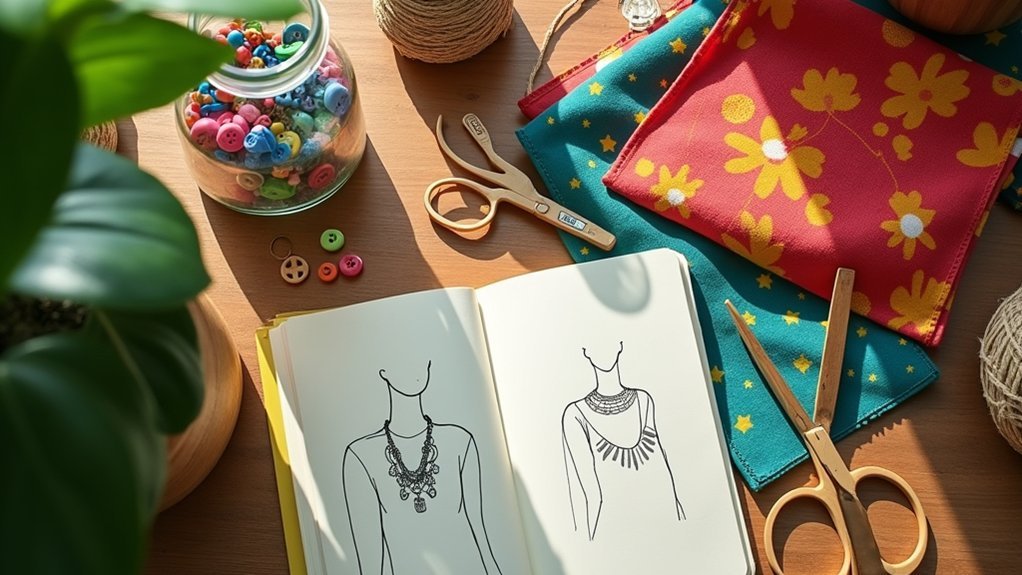
You’ll dramatically reduce environmental impact by establishing thorough waste management systems throughout your production process.
Start with metal scrap collection bins to capture every filing and trimming, then set up water recycling loops that filter and reuse polishing solutions multiple times.
Transform material offcuts into smaller accessories or decorative elements, ensuring nothing valuable ends up in landfills.
Metal Scrap Collection Systems
Although metal waste might seem like an inevitable byproduct of accessory making, you can transform every scrap into a valuable resource with the right collection system. Set up dedicated scrap bins for different metals to guarantee nothing gets wasted during jewelry making.
You’ll want to regularly sweep and collect silver dust and other metal particles throughout your crafting process to maximize material recovery.
Adopt a zero-waste approach by establishing routines for collecting all waste materials, including paper towels and packaging.
Consider separating copper and brass pieces to sell at local scrapyards, generating extra income while supporting recycling efforts. These recycled materials can be refined and reused in future projects, making your workshop both environmentally responsible and economically efficient.
Water Recycling Loop Methods
Since water plays an essential role in most accessory-making processes, implementing a closed-loop recycling system can dramatically reduce your workshop’s environmental impact.
You’ll want to establish a water recycling loop that captures, filters, and reuses water from cleaning tools and rinsing sustainable materials.
Install efficient filtration systems to treat wastewater before reuse, guaranteeing harmful substances don’t contaminate your jewelry making processes.
Supplement your supply by collecting rainwater for non-potable workshop tasks.
Use water-saving spray nozzles and efficient washing systems to minimize consumption during cleaning cycles.
Create awareness among workshop participants about water conservation’s importance.
Regular maintenance of your filtration system guarantees peak performance while protecting local waterways from contamination, making your accessory production truly sustainable.
Material Offcut Repurposing Strategies
While water conservation forms the foundation of sustainable production, transforming material offcuts into valuable resources represents the next essential step toward zero-waste accessory making.
You’ll maximize your workshop’s efficiency by implementing smart repurposing strategies that turn scraps into profits.
Start by establishing a thorough scrap bin system to collect all material offcuts for future refinement. You can transform fabric remnants into patchwork designs and convert metal pieces into decorative charms or embellishments.
- Design modular accessories that accommodate various offcuts and allow easy updates
- Sweep regularly to recover small materials like fabric dust and metal shavings
- Create community material swap events to exchange offcuts with local artisans
- Explore creative applications that incorporate leftover materials into new projects
These sustainable practices promote a circular economy while reducing production waste.
Set Up Material Recovery and Scrap Collection Systems
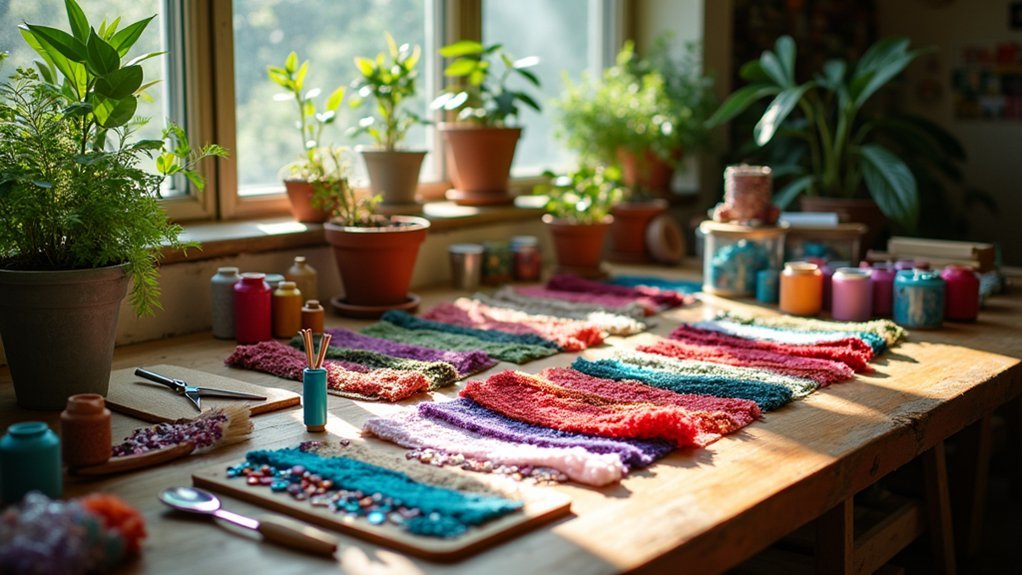
Every piece of metal that falls to your workshop floor represents both wasted money and missed opportunities for sustainable practice.
Every scrap of wasted material in your workshop is money literally hitting the floor and walking away.
You’ll need a designated scrap bin in your workspace to capture all metal waste, ensuring even tiny fragments become recycled metals for future projects. Regularly sweep and collect silver dust from surfaces to recover valuable particles that can be refined and reused.
Create extensive collection systems for all materials used in your studio, including non-metal waste like paper towels. This zero-waste approach greatly reduces your impact on the environment while cutting costs.
Reuse packaging materials such as plastic bags and boxes whenever possible. Establish partnerships with local scrapyards to sell collected copper and brass, ensuring proper recycling and maximizing your sustainable practices.
Use Eco-Friendly Tools and Natural Studio Solutions
Although conventional jewelry-making tools often contain harmful chemicals and non-renewable materials, you can transform your workshop into an eco-conscious space by choosing sustainable alternatives.
Eco-friendly tools featuring bamboo handles or recycled metals greatly reduce your environmental footprint while maintaining professional quality.
Switch to natural adhesives like plant-based glues and beeswax finishes to eliminate toxic chemical exposure in your workspace. These sustainable materials provide excellent bonding strength without compromising your health or the environment.
Consider these essential upgrades for your studio:
- Install LED lighting and energy-efficient equipment to minimize power consumption
- Implement closed-loop water systems for cleaning and polishing processes
- Choose biodegradable packaging materials for shipping finished accessories
- Source tools made from renewable resources whenever possible
These changes create a healthier, more sustainable creative environment.
Create Transparency Around Supply Chain Origins
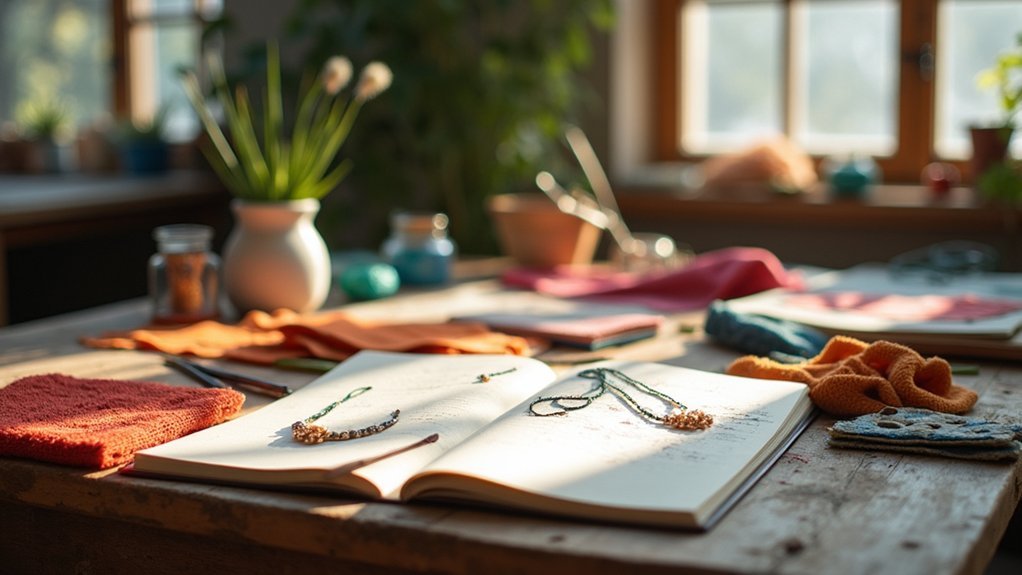
You’ll build consumer trust by clearly documenting where your materials originate and maintaining detailed records of each supplier’s ethical practices.
Share your supplier certification details openly, including Fairtrade or Fairmined credentials that verify responsible sourcing of metals and gemstones.
Communicate your production process steps transparently, from raw material acquisition through final assembly, so customers understand the complete journey of their accessories.
Document Material Source Origins
When you document where your materials come from, you create a transparent foundation that builds customer trust and demonstrates your commitment to ethical practices.
Tracking material origins allows customers to understand the environmental concerns and ethical implications of their purchases while showcasing your dedication to responsible sourcing.
- Seek ethical certifications like Fairtrade and Fairmined to verify precious metals and gemstones come from responsible sources
- Maintain detailed supplier records that document their practices and commitment to ethical mining standards
- Prioritize recycled materials in your documentation to highlight reduced environmental impact from avoiding new extraction
- Engage directly with suppliers to gather thorough information about their sourcing methods and sustainability practices
This transparency enhances your brand’s ethical narrative while promoting accountability throughout your supply chain.
Share Supplier Certification Details
Beyond tracking material origins, sharing specific certification details with your customers amplifies transparency and reinforces your commitment to ethical sourcing.
Display supplier certifications like Fairtrade, Fairmined, and Responsible Jewelry Council badges prominently on your website and product descriptions. When you’re using recycled metals or gemstones, provide documentation that traces their origin and confirms they weren’t sourced from conflict zones.
Transparency in the supply chain becomes powerful when you publicly disclose your suppliers’ practices and certification details.
Don’t just mention you’re ethical and sustainable—prove it with specific documentation. Share certification numbers, renewal dates, and supplier names when possible.
This openness encourages accountability throughout the jewelry industry and helps customers make informed decisions while building trust in your brand’s authentic commitment to responsible practices.
Communicate Production Process Steps
Breaking down your production process into clear, digestible steps transforms complex supply chains into compelling narratives that customers can easily follow and appreciate.
You’ll build trust by documenting each stage, from sourcing recycled metals through ethical mining partnerships to creating finished jewelry pieces. This transparency showcases your commitment to sustainable practices while educating consumers about their purchasing impact.
- Document material origins – Share detailed stories about where your recycled metals come from and their previous uses.
- Map production stages – Create visual timelines showing each step from raw materials to completed accessories.
- Highlight worker conditions – Showcase fair labor practices and safe working environments throughout your supply chain.
- Explain quality controls – Detail testing procedures that guarantee both product excellence and environmental compliance standards.
Focus on Timeless Designs Over Trend-Based Pieces
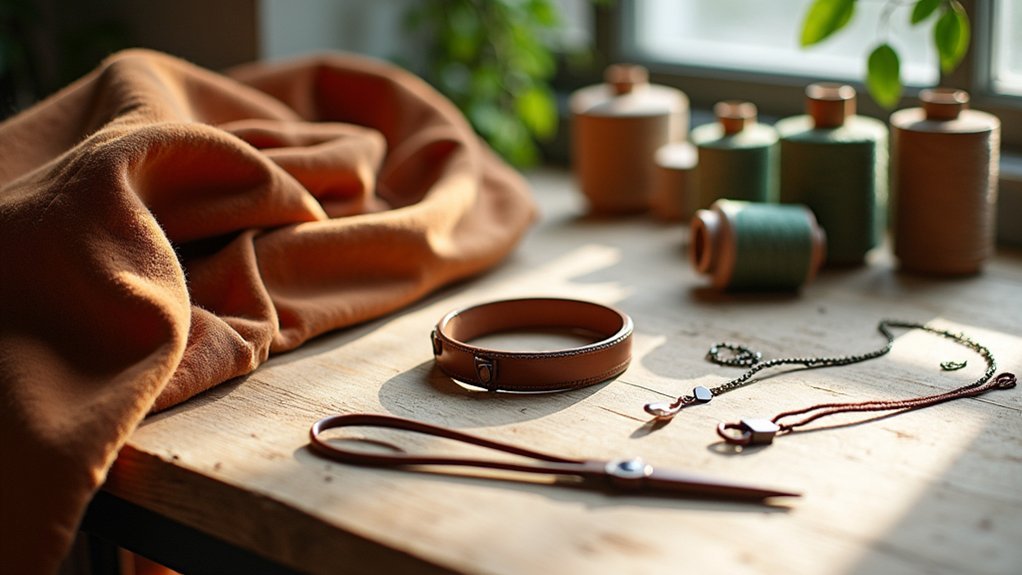
While trends come and go with lightning speed, timeless designs anchor your accessory-making practice in enduring appeal that transcends fleeting fashion moments.
You’ll find that classic shapes and styles remain relevant across seasons, making your pieces valuable long-term investments for customers.
By embracing sustainable practices through timeless aesthetics, you’re encouraging a quality over quantity mindset that reduces waste.
Draw inspiration from historical influences like Art Deco or Victorian elements to create culturally significant pieces that carry lasting appeal.
Focus your craftsmanship on versatile accessories that complement multiple outfits and occasions.
When you prioritize durability and expert construction techniques, you’re creating pieces that stand the test of time, eliminating frequent replacements and supporting sustainable consumption patterns.
Establish Fair Pricing That Reflects True Environmental Costs
When you calculate prices for your sustainable accessories, you must account for the complete environmental footprint rather than settling for conventional market rates that ignore ecological damage.
Your pricing formula should encompass materials from ethical suppliers, labor costs, overhead expenses, and a profit margin supporting sustainable practices.
Transparent pricing educates consumers about the true value of eco-conscious products, helping them understand why sustainably made accessories cost more than mass-produced alternatives.
Consider these essential pricing components:
- Environmental impact costs including pollution prevention and resource conservation
- Premium expenses for sourcing from ethical suppliers
- Emotional labor for customer service and community engagement
- Long-term environmental costs traditionally externalized by conventional producers
Build Community Through Storytelling and Shared Values
You’ll create meaningful connections with fellow makers by sharing the authentic stories behind your materials—where they came from, how they were sourced, and why you chose them.
Form groups with people who share your environmental values and commitment to ethical practices, as this alignment strengthens your collective purpose.
When you openly discuss your material choices and values with others, you’ll build a supportive community that reinforces everyone’s dedication to sustainable accessory making.
Share Material Origin Stories
Because every material carries a history worth sharing, telling the origin stories of your sourcing choices transforms simple accessories into meaningful connections with your customers.
When you detail how recycled metals were reclaimed from electronic waste or how your gemstones support fair labor practices, you’re educating consumers about ethical sourcing while building trust.
- Highlight environmental impact: Explain how your sustainable materials reduce mining pollution and preserve natural resources.
- Share community stories: Detail how your sourcing decisions support artisan communities and fair wages.
- Document your journey: Tell personal anecdotes about discovering eco-friendly suppliers and learning sustainable practices.
- Connect values: Help jewelry artists understand how their purchasing decisions align with environmental and social responsibility.
These narratives enhance perceived value while fostering deeper customer relationships.
Create Values-Based Groups
Material stories that resonate with individual customers become even more powerful when shared within a community of like-minded makers. When you create values-based groups, you’ll foster deeper connections through storytelling about your sustainable practices and ethical craftsmanship journey.
Encourage participants to articulate their commitment to environmental stewardship and social responsibility. These discussions create supportive environments where everyone contributes to your collective sustainability mission. You’ll find that sharing personal experiences related to ethical crafting helps participants understand their choices’ broader impact.
| Group Activity | Sustainability Benefit |
|---|---|
| Material sourcing stories | Increased awareness of supply chains |
| Environmental impact discussions | Enhanced eco-conscious decision making |
| Local artisan partnerships | Strengthened sustainable networks |
| Ethical crafting workshops | Improved responsible practices |
| Values alignment sessions | Unified community purpose |
Your values-based groups can facilitate partnerships with local artisans and sustainable brands.
Partner With Certified Sustainable Suppliers and Organizations
When you’re ready to take your sustainable accessory making to the next level, partnering with certified sustainable suppliers becomes essential for ensuring your materials meet the highest ethical standards and environmental responsibility.
Collaborate with the Responsible Jewelry Council to establish transparent supply chains and access guidance on best practices. These partnerships provide access to recycled metals and ethically sourced gemstones, dramatically reducing your workshop’s carbon footprint.
- Seek Fairtrade and Fairmined certifications when selecting material suppliers
- Access recycled metals and ethically sourced gemstones through verified networks
- Support community reinvestment initiatives that promote fair labor practices
- Participate in mercury cleanup projects and environmental restoration efforts
Frequently Asked Questions
How Do I Calculate Emotional Labor Costs When Pricing Handmade Accessories?
You can’t directly quantify emotional investment, but you should factor in stress, creative energy, and personal attachment by adding 15-30% to your base pricing to honor your complete creative process.
What Storytelling Techniques Work Best for Building Customer Relationships in Workshops?
You’ll connect deeply through personal creation stories, sharing your design inspiration and material sources. Ask participants about their style preferences, encourage them to share their own experiences, and create collaborative moments where everyone contributes ideas.
How Can I Maintain Quality While Using Only Reclaimed Materials?
You’ll maintain quality by carefully inspecting each reclaimed piece, sorting materials by condition, and cleaning thoroughly before use. Test durability, mix reclaimed with small amounts of new hardware when necessary.
What Insurance Coverage Do I Need for Hosting Sustainable Crafting Workshops?
You’ll need general liability insurance covering participant injuries, property damage, and product liability. Consider professional indemnity insurance for instruction errors. Check if your venue’s insurance covers workshops or if you need separate event coverage for materials and tools.
How Do I Handle Participants With Different Skill Levels Effectively?
You’ll create mixed-ability pairs where experienced crafters mentor beginners. Prepare simplified versions of complex techniques and offer optional advanced challenges. Circulate frequently, providing individualized guidance while maintaining everyone’s engagement throughout the session.
In Summary
You’ve got the foundation for creating beautiful accessories that don’t compromise the planet. Start with one or two techniques that resonate most with you, then gradually incorporate others as your workshop evolves. Remember, you’re not just making jewelry—you’re crafting a movement toward conscious consumption. Your customers will appreciate the transparency, and you’ll sleep better knowing your creative passion aligns with your environmental values.


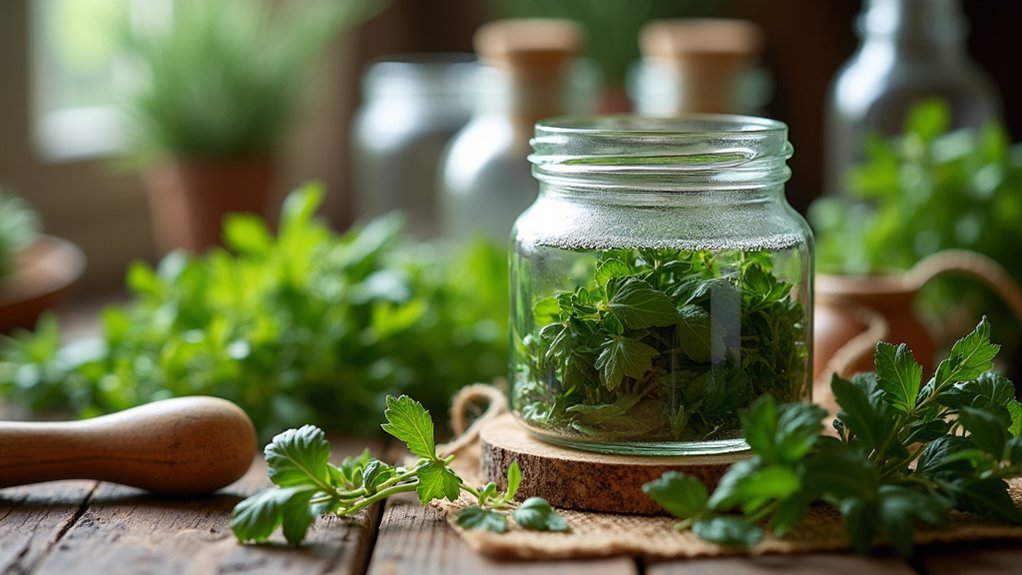
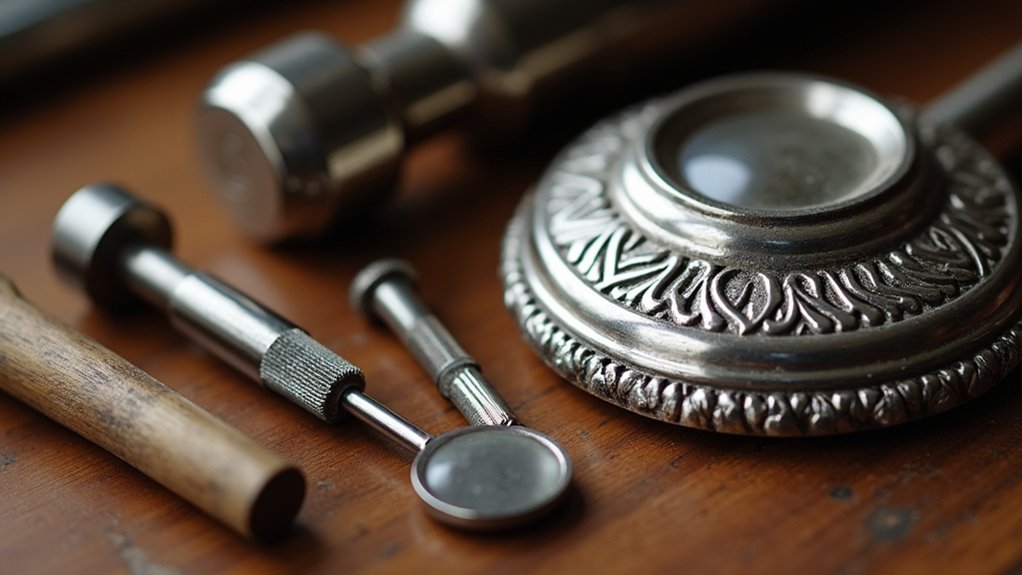
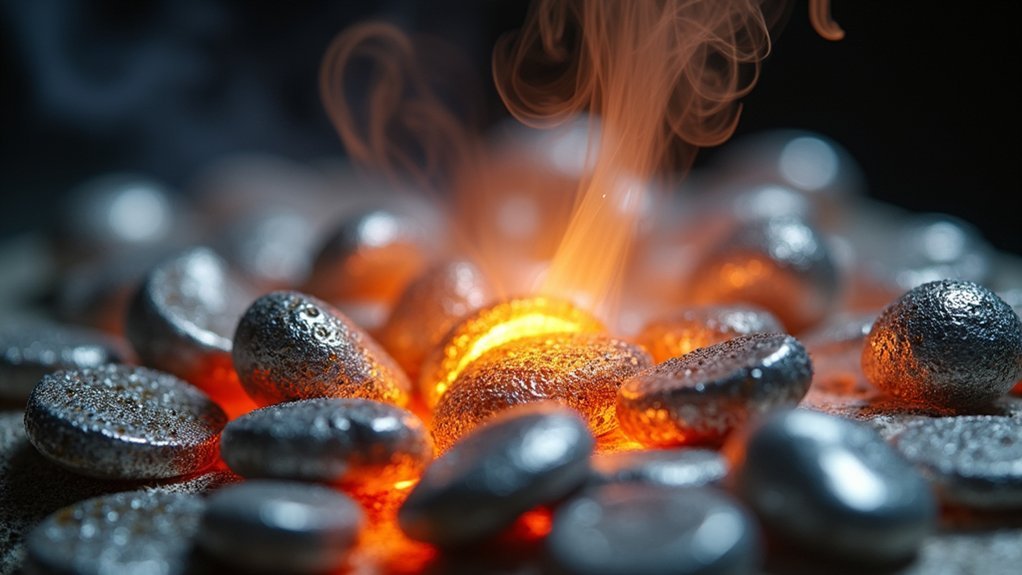
Leave a Reply